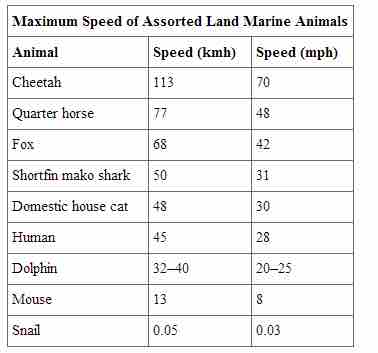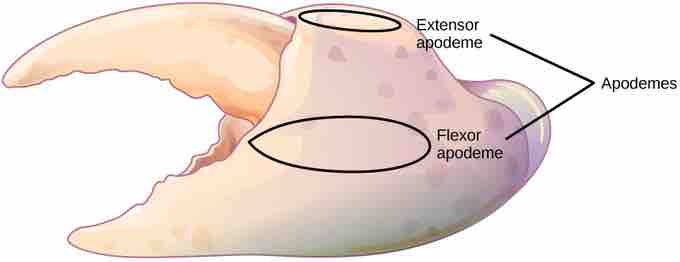Limits on Animal Size and Shape
Animals with bilateral symmetry that live in water tend to have a fusiform shape: a tubular shaped body that is tapered at both ends. This shape decreases the drag on the body as it moves through water and allows the animal to swim at high speeds . Certain types of sharks can swim at fifty kilometers an hour, while some dolphins can swim at 32-40 kilometers per hour. Land animals frequently travel faster (although the tortoise and snail are significantly slower than sharks or dolphins). Another difference in the adaptations of aquatic and land-dwelling organisms is that aquatic organisms are constrained in shape by the forces of drag in the water since water has higher viscosity than air. However, land-dwelling organisms are constrained mainly by gravity; drag is relatively unimportant. For example, most adaptations in birds are for gravity, not for drag.

Animal speeds
Land and marine animals travel at varying speeds. Land animals usually travel at higher speeds, but marine animals such as dolphins and sharks travel relatively fast.
Most animals have an exoskeleton, including insects, spiders, scorpions, horseshoe crabs, centipedes, and crustaceans. Scientists estimate that, of insects alone, there are over 30 million species on our planet. The exoskeleton is a hard covering or shell that provides benefits to the animal, such as protection against damage from predators and from water loss (for land animals); it also provides for the attachments of muscles. As the tough and resistant outer cover of an arthropod, the exoskeleton may be constructed of a tough polymer, such as chitin, and is often biomineralized with materials, such as calcium carbonate. This is fused to the animal's epidermis. Ingrowths of the exoskeleton called apodemes function as attachment sites for muscles, similar to tendons in more advanced animals . In order to grow, the animal must first synthesize a new exoskeleton underneath the old one and then shed or molt the original covering. This limits the animal's ability to grow continually. It may limit the individual's ability to mature if molting does not occur at the proper time. The thickness of the exoskeleton must be increased significantly to accommodate any increase in weight. It is estimated that a doubling of body size increases body weight by a factor of eight. The increasing thickness of the chitin necessary to support this weight limits most animals with an exoskeleton to a relatively-small size.

Apodemes
Apodemes are ingrowths on arthropod exoskeletons to which muscles attach. The apodemes on this crab leg are located above and below the fulcrum of the claw. Contraction of muscles attached to the apodemes pulls the claw closed.
The same principles apply to endoskeletons, but they are more efficient because muscles are attached on the outside, making it easier to compensate for increased mass. An animal with an endoskeleton has its size determined by the amount of skeletal system it needs in order to support the other tissues and the amount of muscle it needs for movement. As the body size increases, both bone and muscle mass increase. The speed achievable by the animal is a balance between its overall size and the bone and muscle that provide support and movement.